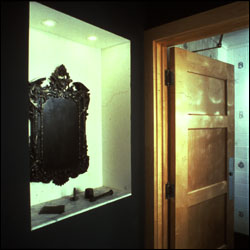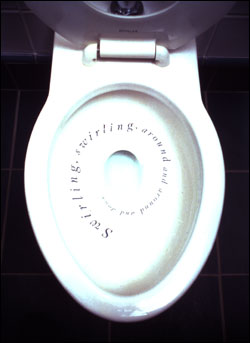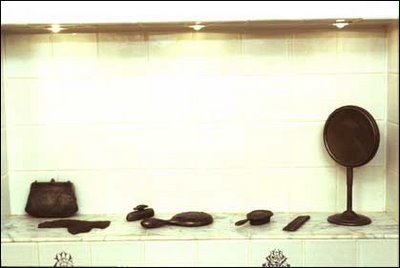Emptying and Filling
The previously posted series of nine photographs, an ambiguous narrative showing a woman in a red velvet robe, began as part of an installation I did for the Kohler Art Center in Wisconsin. It was a commission to do a functioning public women's restroom for the museum, including three toilet stalls, two sinks, and an entrance area. All the objects you see--mirror, brush, comb, lipstick, lace handkerchief--are cast iron. They were cast by me in the Kohler plumbing corporation's giant industrial foundry in Wisconsin, which resembles the Pittsburgh Steel Works. Think B I G, the size of several NYC blocks, filled with terrifying machines. Think 110 degrees in August, shoving carts loaded with 500 lb. molds. The Kohler Weight Loss Program & Spa. It practically killed me. I also did the porcelain ceramic work in their giant-- BBBBIIIIIIGGGGGG, HUMONGOUS --industrial pottery, having never made anything in ceramics before. "Oh sure, I can do that."
You can see crappy, low rez pictures below, showing glimpses of the photos installed, and read some of the reviews. Of course my favorite is, "If Miss Universe was a restroom competition, six finalists would reside in Sheboyan, WI." The series of photographs are coming out in a book, "Picturing Women", published by Penn State Press and curated by Susan Shifrin, an art history fellow at Bryn Mawr. The entire project will be part of another book "The Object of Labor: Critical Perspectives on Art, Cloth, and Cultural Production", published by the School of the Art Institute of Chicago and curated by Joan Livingstone and John Ploof.
Meanwhile I'm working on my next soothing knitting project--oooooo, cool colors!--and catching zzzzzzs with my canine & hub, both cute and fuzzy. And both sleep with their tongues out.





MERRILL MASON: FILLING AND EMPTYING
Well known for her unusual and sensuous fiber works, artist Merrill Mason worked in metal for the first time when she was an Arts/Industry artist-in-residence in the Kohler Co. Foundry in 1996. While there, she produced a series of cast iron "lace" collars, which have the elegance of lace but, at the same time, almost seem to be objects of torture because of the immutable iron. That body of work served as the point of departure for the design of her restroom titled Emptying and Filling. Before visitors even enter the washroom, they come upon inviting still lifes of cast-iron perfume bottles, lace-edged and embroidered linens, gloves, an evening purse, lipstick, mirrors, and combs at either side of the entrance. Two more still lifes inside the washroom continue the concept of a "woman's room." Also utilizing the Kohler Corporation Pottery, Mason created ceramic wall tiles adorned with antique monograms. On the inside surface of each stall door as well as on one wall are lush photographs of a woman in a red robe holding the cast-iron accessories or a coil of hair. The washroom takes its name from the words "emptying and filling" which encircle the inside of one of the lavatories. Text is an equally surprising element on the interior of one of the toilet bowls where "swirling, swirling, around and around and down" mimics the flow of water. Mason's restroom explores the boundaries between public and private through objects associated with women and bathrooms.
Emptying and Filling by Merrill Mason
- East Wing women's washroom
Before you even enter this quirky room, you’re welcomed on both sides of the entrance by perfume bottles, lace-edged and embroidered linens, gloves, an evening purse, lipstick, mirrors and combs. But there’s something special about this collection of delicate items: They’re all made of cast-iron. Photographs of a lady in red holding various cast-iron accessories adorn the stalls and walls. So what's with the name? Close inspection reveals the phrase in the text lining a sink. Mason’s first work in metal came during her Arts/Industry artist-in-residence stint at Kohler Company's foundry in 1996. Already known for her unusual fiber work, she began making elegant, "lace" collars in cast iron. Emptying and Filling is a tongue-in-cheek commentary on the distinctly feminine items one associates with a bathroom while not shying away from the room’s purpose. The theme is conveyed in the diminishing text inside a toilet: "Swirling, swirling, around and around and down."
World’s Best Bathrooms-Editors Choice
The John Michael Kohler Arts Center
608 New York Avenue
Sheboygan, Wisconsin, USA
If Miss Universe was a restroom competition, six finalists would reside in Sheboyan, WI. Kohler sponsored six artists to design sculpture and art using technology and materials from Kohler. Transcending function, these bathrooms are spectacular.
EVEN THE WASHROOMS ARE WORKS OF ART AT THE JOHN MICHAEL KOHLER ARTS CENTER
One of the most unusual aspects of the John Michael Kohler Arts Center's 99,000 square-foot facility is its six public washrooms, each of which was created by an outstanding American artist in the Arts Center's renowned Arts/Industry program. Initiated in 1974 as a means of supporting artists, Arts/Industry gives artists the opportunity to create whole new bodies of sculpture and other works of art using the facilities, technologies, and materials of nearby plumbingware manufacturer, Kohler Co. Up to 22 artists from around the world spend 2-6 months each year in residence in the company's pottery, iron and brass foundry, and/or enamel shop creating works they could not undertake in their own studios.
Through the years, several artists have created major public commissions for sites across the United States, from federal and state office buildings to parks and mass transit stations. However, the six washrooms were the first commissions ever undertaken for the Arts Center itself. The commissions were funded through the Campaign for a New Arts Center for a New Century to which over 2800 contributors gave $20.5 million. The washrooms are indicative of the Arts Center's efforts to make the arts an integral part of adult's and children's lives through nationally acclaimed visual and performing arts programming.
The six washrooms include:
Sheboygan Men's Room by Ann Agee - the East Wing men's washroom
Emptying and Filling by Merrill Mason - the East Wing women's washroom
Childhood Vitreous by Casey O'Connor and 70 three- and five-year olds - the Children's Studio washroom
Tell Me Something I Don't Already Know by Carter Kustera - a family washroom
The Social History of Architecture by Matt Nolen - the main entrance men's washroom
The Women's Room by Cynthia Consentino - the main entrance women's washroom
Because the Arts Center focuses on ever-changing exhibitions and performances, the galleries and most other spaces had to serve as a "blank canvas" for both the visual and performing works that would be presented. Thus the washrooms were the only public spaces where permanently installed works of art could be considered. In addition, the washroom commissions were particularly fitting because of the Arts Center's focus on the support of new work and on involving artists and the public together in the creative process. The six artists worked alongside the men and women of Kohler Co.-casters, moldmakers, grinders, etc.-who provided their expertise and helping hands every step of the way.
Because the Arts Center's mission emphasizes the support of emerging and mid-career artists, it was decided to work with six artists who had not had the opportunity to create major public works. Five of them, Anne Agee, Carter Kustera, Merrill Mason, Yolande Macias McKay, and Casey O'Connor, had previously been artists-in-residence in the Arts/Industry program. Matt Nolen came to the program for the first time to create his commission.
Visitor Response
The John Michael Kohler Arts Center's public washrooms have become such magnetic attractions that they are generally a part of every tour. And female visitors can often be seen knocking on the men's rooms doors and vice versa. More amazing, however, are the sounds which emanate from the washrooms. Carter Kustera's Tell Me Something I Don't Already Know elicits first a hesitant chuckle and then louder and louder guffaws as more and more of the fantasy "portraits" are enjoyed. Visitors often remark with a smile that Kustera's images and text eliminate the need to bring reading material to a bathroom.
Matt Nolen's washroom, The Social History of Architecture, evokes awed silence upon entering, then screams of delight as visitors begin to fully comprehend the imagery, and finally mutterings such as "I can't believe it. I just pretended I was an Egyptian pharaoh." Viewing Merrill Mason's Emptying and Filling washroom is a quieter experience. On one hand, visitors are astounded by the technical skill involved in casting laces and embroideries so exquisitely in iron. On the other hand, they become steeped in issues of femininity.
The John Michael Kohler Arts Center is known nationally for the breadth and fascination of its ever-changing, ever-new exhibitions, performances, and other programming. Its washrooms are equally amazing and, like old friends, they are always there for visitors
You can see crappy, low rez pictures below, showing glimpses of the photos installed, and read some of the reviews. Of course my favorite is, "If Miss Universe was a restroom competition, six finalists would reside in Sheboyan, WI." The series of photographs are coming out in a book, "Picturing Women", published by Penn State Press and curated by Susan Shifrin, an art history fellow at Bryn Mawr. The entire project will be part of another book "The Object of Labor: Critical Perspectives on Art, Cloth, and Cultural Production", published by the School of the Art Institute of Chicago and curated by Joan Livingstone and John Ploof.
Meanwhile I'm working on my next soothing knitting project--oooooo, cool colors!--and catching zzzzzzs with my canine & hub, both cute and fuzzy. And both sleep with their tongues out.





MERRILL MASON: FILLING AND EMPTYING
Well known for her unusual and sensuous fiber works, artist Merrill Mason worked in metal for the first time when she was an Arts/Industry artist-in-residence in the Kohler Co. Foundry in 1996. While there, she produced a series of cast iron "lace" collars, which have the elegance of lace but, at the same time, almost seem to be objects of torture because of the immutable iron. That body of work served as the point of departure for the design of her restroom titled Emptying and Filling. Before visitors even enter the washroom, they come upon inviting still lifes of cast-iron perfume bottles, lace-edged and embroidered linens, gloves, an evening purse, lipstick, mirrors, and combs at either side of the entrance. Two more still lifes inside the washroom continue the concept of a "woman's room." Also utilizing the Kohler Corporation Pottery, Mason created ceramic wall tiles adorned with antique monograms. On the inside surface of each stall door as well as on one wall are lush photographs of a woman in a red robe holding the cast-iron accessories or a coil of hair. The washroom takes its name from the words "emptying and filling" which encircle the inside of one of the lavatories. Text is an equally surprising element on the interior of one of the toilet bowls where "swirling, swirling, around and around and down" mimics the flow of water. Mason's restroom explores the boundaries between public and private through objects associated with women and bathrooms.
Emptying and Filling by Merrill Mason
- East Wing women's washroom
Before you even enter this quirky room, you’re welcomed on both sides of the entrance by perfume bottles, lace-edged and embroidered linens, gloves, an evening purse, lipstick, mirrors and combs. But there’s something special about this collection of delicate items: They’re all made of cast-iron. Photographs of a lady in red holding various cast-iron accessories adorn the stalls and walls. So what's with the name? Close inspection reveals the phrase in the text lining a sink. Mason’s first work in metal came during her Arts/Industry artist-in-residence stint at Kohler Company's foundry in 1996. Already known for her unusual fiber work, she began making elegant, "lace" collars in cast iron. Emptying and Filling is a tongue-in-cheek commentary on the distinctly feminine items one associates with a bathroom while not shying away from the room’s purpose. The theme is conveyed in the diminishing text inside a toilet: "Swirling, swirling, around and around and down."
World’s Best Bathrooms-Editors Choice
The John Michael Kohler Arts Center
608 New York Avenue
Sheboygan, Wisconsin, USA
If Miss Universe was a restroom competition, six finalists would reside in Sheboyan, WI. Kohler sponsored six artists to design sculpture and art using technology and materials from Kohler. Transcending function, these bathrooms are spectacular.
EVEN THE WASHROOMS ARE WORKS OF ART AT THE JOHN MICHAEL KOHLER ARTS CENTER
One of the most unusual aspects of the John Michael Kohler Arts Center's 99,000 square-foot facility is its six public washrooms, each of which was created by an outstanding American artist in the Arts Center's renowned Arts/Industry program. Initiated in 1974 as a means of supporting artists, Arts/Industry gives artists the opportunity to create whole new bodies of sculpture and other works of art using the facilities, technologies, and materials of nearby plumbingware manufacturer, Kohler Co. Up to 22 artists from around the world spend 2-6 months each year in residence in the company's pottery, iron and brass foundry, and/or enamel shop creating works they could not undertake in their own studios.
Through the years, several artists have created major public commissions for sites across the United States, from federal and state office buildings to parks and mass transit stations. However, the six washrooms were the first commissions ever undertaken for the Arts Center itself. The commissions were funded through the Campaign for a New Arts Center for a New Century to which over 2800 contributors gave $20.5 million. The washrooms are indicative of the Arts Center's efforts to make the arts an integral part of adult's and children's lives through nationally acclaimed visual and performing arts programming.
The six washrooms include:
Sheboygan Men's Room by Ann Agee - the East Wing men's washroom
Emptying and Filling by Merrill Mason - the East Wing women's washroom
Childhood Vitreous by Casey O'Connor and 70 three- and five-year olds - the Children's Studio washroom
Tell Me Something I Don't Already Know by Carter Kustera - a family washroom
The Social History of Architecture by Matt Nolen - the main entrance men's washroom
The Women's Room by Cynthia Consentino - the main entrance women's washroom
Because the Arts Center focuses on ever-changing exhibitions and performances, the galleries and most other spaces had to serve as a "blank canvas" for both the visual and performing works that would be presented. Thus the washrooms were the only public spaces where permanently installed works of art could be considered. In addition, the washroom commissions were particularly fitting because of the Arts Center's focus on the support of new work and on involving artists and the public together in the creative process. The six artists worked alongside the men and women of Kohler Co.-casters, moldmakers, grinders, etc.-who provided their expertise and helping hands every step of the way.
Because the Arts Center's mission emphasizes the support of emerging and mid-career artists, it was decided to work with six artists who had not had the opportunity to create major public works. Five of them, Anne Agee, Carter Kustera, Merrill Mason, Yolande Macias McKay, and Casey O'Connor, had previously been artists-in-residence in the Arts/Industry program. Matt Nolen came to the program for the first time to create his commission.
Visitor Response
The John Michael Kohler Arts Center's public washrooms have become such magnetic attractions that they are generally a part of every tour. And female visitors can often be seen knocking on the men's rooms doors and vice versa. More amazing, however, are the sounds which emanate from the washrooms. Carter Kustera's Tell Me Something I Don't Already Know elicits first a hesitant chuckle and then louder and louder guffaws as more and more of the fantasy "portraits" are enjoyed. Visitors often remark with a smile that Kustera's images and text eliminate the need to bring reading material to a bathroom.
Matt Nolen's washroom, The Social History of Architecture, evokes awed silence upon entering, then screams of delight as visitors begin to fully comprehend the imagery, and finally mutterings such as "I can't believe it. I just pretended I was an Egyptian pharaoh." Viewing Merrill Mason's Emptying and Filling washroom is a quieter experience. On one hand, visitors are astounded by the technical skill involved in casting laces and embroideries so exquisitely in iron. On the other hand, they become steeped in issues of femininity.
The John Michael Kohler Arts Center is known nationally for the breadth and fascination of its ever-changing, ever-new exhibitions, performances, and other programming. Its washrooms are equally amazing and, like old friends, they are always there for visitors




2 Comments:
THAT is so cool you casted all that yourself. You're very talented.
Hello, I am an art student at the University of Alabama at Birmingham and in my metal casting class we were assigned an artist critique. You were one of the names on the list that we blindly chose names from. I had no idea what your work was like until just a moment ago although I am happy to have chosen your name because I am really intrigued by your castings. My favorite is the mirror, I was just talking to my sculpture teacher about casting mirrors yesterday before I even saw your work. My work has been dealing a lot lately with the idea of body image / narcissism / vanity /etc. I just wanted let you know that I found your work to be inspiring. Thanks, Krysta
Post a Comment
<< Home